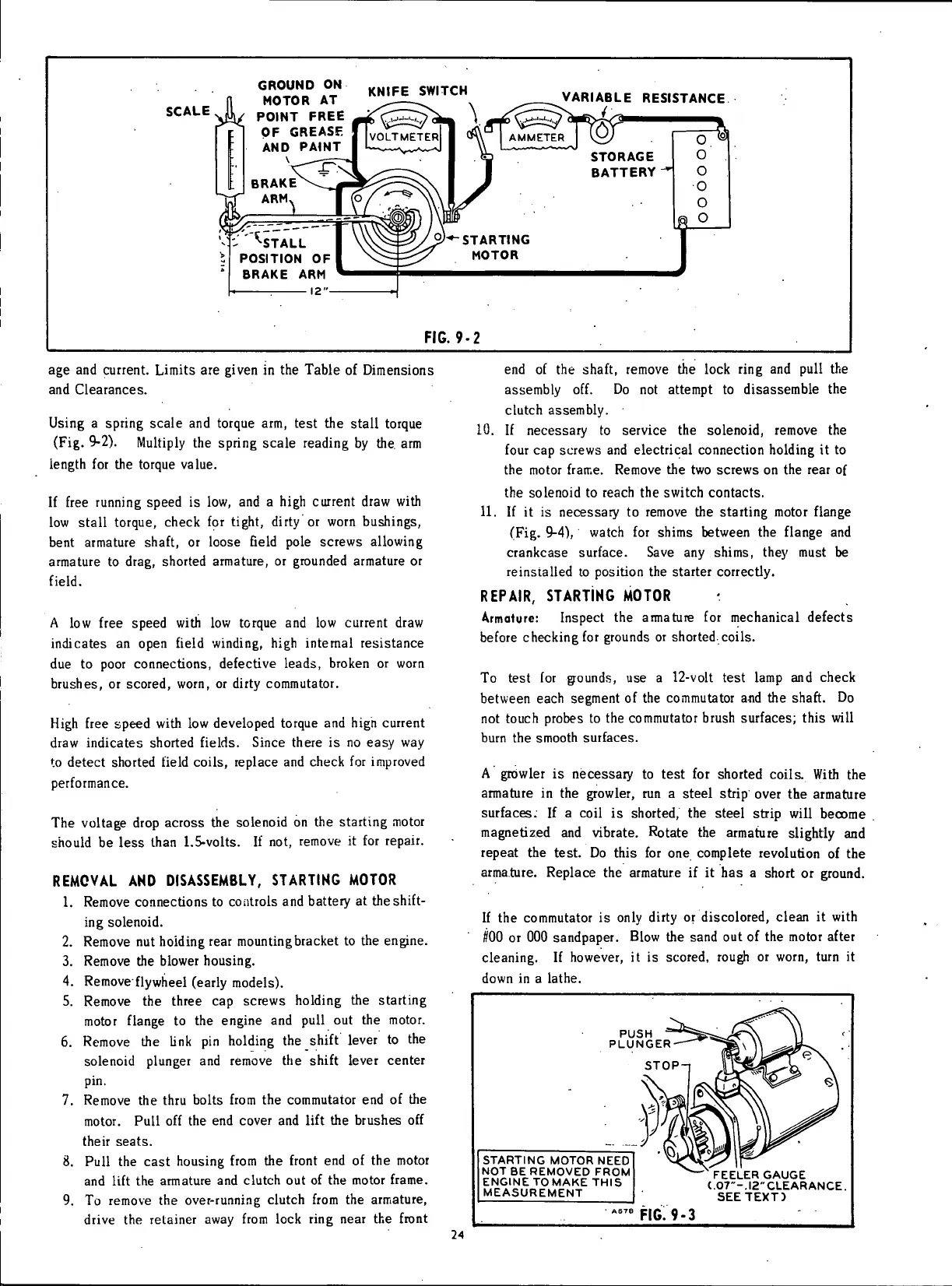KNIFE
SWITCH
SCALE
GROUND
ON
fl
MOTOR
AT .
UW
POINT FREE
^^^S^ \
OF GREASE
^ ^ ^ ^
AND
PAINT
VARIABLE
RESISTANCE
FIG.
9-2
age and current.
Limits
are given in the Table of Dimensions
and Clearances.
Using
a spring
scale
and torque arm, test the
stall
torque
(Fig.
9-2).
Multiply
the spring
scale
reading by the. arm
length
for the torque value.
If
free running
speed
is low, and a
high
current draw
with
low
stall
torque, check for
tight,
dirty'or
worn
bushings,
bent armature shaft, or loose
field
pole screws
allowing
armature to drag, shorted armature, or grounded armature or
field.
A
low free
speed
with
low torque and low current draw
indicates an open
field
winding,
high
intemal resistance
due to poor connections, defective leads, broken or
worn
brushes, or scored,
worn,
or
dirty
commutator.
High
free
speed
with
low
developed torque and
high
current
draw
indicates shorted
fields.
Since there is no
easy
way
to
detect shorted
field
coils,
replace and check for improved
performance.
The voltage drop
across
the solenoid on the starting motor
should
be
less
lhan 1.5-volts. If not, remove it for repair.
REMOVAL
AND
DISASSEMBLY,
STARTING
MOTOR
1.
Remove connections to
coiitrols
and battery at
the
shift-
ing
solenoid.
2.
Remove nut
holding
rear
mounting
bracket
to the engine.
3. Remove the blower housing.
4.
Remove
flywheel
(early models).
5. Remove the three cap screws
holding
the starting
motor
flange to the engine and
pull
out the motor.
6. Remove the Unk pin
holding
the
shift
lever to the
solenoid
plunger and remove the
shift
lever center
pin.
7. Remove the
thru
bolts
from
the commutator end of the
motor.
Pull
off the end cover and
lift
the
brushes
off
their
seats.
8.
Pull
the
cast
housing
from
the
front
end of the motor
and
lift
the armature and
clutch
out of the motor frame.
9. To remove the over-running
clutch
from
the armature,
drive
the retainer away
from
lock
ring
near
the
front
end of the shaft, remove the
lock
ring
and
pull
the
assembly off. Do not attempt to disassemble the
clutch
assembly.
10.
If
necessary
to service the solenoid, remove the
four
cap screws and electrical connection
holding
it to
the motor
frame.
Remove the two screws on the rear
of
the solenoid to reach the
switch
contacts.
11.
If it is
necessary
to remove the starting motor flange
(Fig.
9-4), watch for shims between the flange and
crankcase surface.
Save
any shims, they must be
reinstalled
to position the starter correctly.
REPAIR,
STARTING
MOTOR
Armoture:
Inspect the aimature for mechanical defects
before checking
for
grounds or shorted.coils.
To
test for g-ounds, use a
12-volt
test lamp and check
between each segment of the commutator and the shaft. Do
not
touch probes to the commutator brush surfaces; this
will
burn
the smooth surfaces.
A
growler is
necessary
to test for shorted
coils.
With
the
armature in the growler, run a steel strip over the armature
surfaces. If a
coil
is shorted, the steel strip
will
become
magnetized and vibrate. Rotate the armature
slightly
and
repeat
the test. Do this for one complete
revolution
of the
armature. Replace the armature if it has a short or ground.
If
the commutator is
only
dirty
or discolored, clean it
with
#00 or 000
sandpaper.
Blow
the sand out of the motor after
cleaning.
If however, it is scored, rough or
worn,
turn
it
down
in a lathe.
PUSH
PLUNGER
STARTING
MOTOR
NEED
NOT
BE
REMOVED
FROM
ENGINE
TO
MAKE
THIS
MEASUREMENT
'
FEELER
GAUGE
C.07"-.I2"CLEARANCE.
SEE
TEXT)
FIG.
9-3
24

